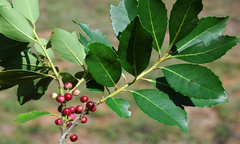Yerba Mate: The Spirit of Uruguay lives in UPM Forestal Oriental's natural forests
No matter what corner of the world we are in, a person drinking mate publicly even in the most bizarre situation means just one thing: he or she comes from the Rio de la Plata region, almost certainly from Uruguay.
Utensils used may indicate whether the person comes from Uruguay, Argentina, or perhaps from southern Brazil, but that does not matter, what does matter is that this infusion is one of the strongest cultural identity icons anywhere in the world.
We Uruguayans drink mate at almost all hours of the day, either alone or socially and therefore we carry the implements to prepare and drink it wherever we go, whether at home, attending a class at the university, in a board meeting or walking along the Great Wall in China.
Mate is an infusion that is prepared using dried leaves of a subtropical tree species, the Yerba Mate (Ilex paraguariensis, Aquifoliaceae), placed in a pumpkin-like container (the mate itself) to which hot water (at 80C or hotter) is added and then the bitter tasting liquid is sucked through a metal tube bulb in a process that is repeated again and again until the infusion loses its flavour, or the water in the thermal bottle is finished.
Originally from the ancient Guarani indigenous populations, the tradition spread out to several countries in South America because of the Jesuit Missions, who played a crucial role in disseminating this habit during the 17th and 18th centuries, domesticating the tree species and promoting farming and trade, becoming the main income of the Missions in this region of the world at that time. The mate tradition remains today in Argentina, Uruguay, Paraguay, southern Brazil and parts of Chile and Bolivia, though in many cases only in rural areas.
The natural range of the Yerba Mate tree (Ilex paraguariensis) includes southern Brazil, northern Argentina, Paraguay and Uruguay (northeast and east), but curiously the species whose leaves are so tied to national identity is not widely known in Uruguay because it only grows in some humid gullies and gallery forests, protected from winter frosts. That is the reason why industrial scale cultivation is not possible in Uruguay.
Despite this, there are native populations of Yerba Mate living in natural forest conserved by UPM Forestal Oriental in the Tacuarembó (Cerro del Arbolito) and Cerro Largo (Arevalo) regions, discovered by our environmental surveys and monitoring programme.
In these places, protected from frost and with high humidity and shade, many specimens grow up to 10-15 metres tall and their stems up to 20-30 centimetres wide diameter, while also small specimens and seedlings are growing around, ensuring the population’s viability as long as the environmental conditions are maintained.
UPM Forestal Oriental’s Eucalyptus plantations do not affect the viability of the Yerba Mate populations given that buffer zones between plantations and native forests are kept, thereby maintaining the natural conditions of the site including water flow and shade. Native forests are highlighted in operational maps to ensure that the forestry operations are kept out, and any exotic invasive species are monitored and controlled if necessary.
UPM carries out biodiversity surveys and monitoring activities in areas where these surveys had not been done before, thus increasing and enriching national biological collections, establishing conservation programmes, and protecting high conservation value areas.
Thus, even though they are small populations, the title of this article is pertinent: the spirit of Uruguay lives in our forests.

